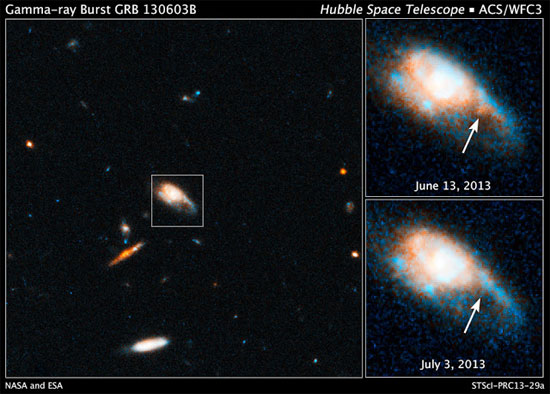Decoding the origin of phenomena
Astronomers say the Hubble space telescope has discovered a gamma-ray explosion from the event named kilonova, temporarily translating "exploding thousands of stars".
Faced with Hubble's infrared light receiver, kilonova represents a new form of gamma-ray burst, derived from the fusion of two objects, usually neutron stars, Space.com, which leads to the announcement of the Aviation Authority. and the US Universe (NASA).

The explosion of gamma rays has just reached the Hubble and Swift observations.(Photo: NASA)
The kilonova is 1,000 times brighter than a normal stellar explosion, ie nova, which occurs when a white dwarf explodes, but is only one-tenth to one-hundredth the brightness of a supernova, the self-destruction of a giant star.
After the gamma-ray burst caught sight of the Swift telescope on June 3, Hubble continued to track the area for nine days in search of the remnants of the explosion, and it also spotted a light red objects here.
Astrophysicists predict that short gamma-ray bursts can be formed when two super-compressed neutron stars of the binary star system collide, and Hubble's observations prove this connection. between gamma ray bursts with kilonova.
'This observation has finally deciphered the mysterious source of gamma-ray bursts' , said Leicester University's Nial Tanvir.
Previously, experts have demonstrated long-term gamma-ray bursts (with the entire process taking more than 2 seconds) due to the collapse of massive stars.
- 10 spooky phenomena under a scientific perspective
- 'Decoding' origin of Antarctic dust
- Pilot's Glory Decoding: the aura of common pilots
- Ten phenomena have no solution
- Paranormal phenomena from the universe
- Discover unique natural phenomena
- Decode cheap DNA
- The most incredible natural phenomena in the world
- Decoding eclipse phenomenon, eclipse appears in the month
- 'Rare and difficult to find' natural phenomena
- The most bizarre phenomena on Earth
- 8 natural scientific phenomena cannot explain
 Van Allen's belt and evidence that the Apollo 11 mission to the Moon was myth
Van Allen's belt and evidence that the Apollo 11 mission to the Moon was myth The levels of civilization in the universe (Kardashev scale)
The levels of civilization in the universe (Kardashev scale) Today Mars, the sun and the Earth are aligned
Today Mars, the sun and the Earth are aligned The Amazon owner announced a secret plan to build a space base for thousands of people
The Amazon owner announced a secret plan to build a space base for thousands of people